Modern beekeeping in Belarus
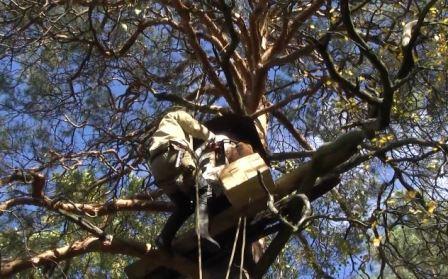
Beekeeping in Belarus is a very ancient craft. This was facilitated by a large number of forests that covered the entire territory of the modern Republic of Belarus. How beekeeping in Belarus developed and what is modern beekeeping in Belarus.
History of beekeeping in Belarus
According to some assumptions, the ancestors of the Slavs, back in the 1st century AD, already used boards to keep bees.
At the same time, almost until the 19th century, both the creation of side apiaries in the forest, the removal of side apiaries and beehives in the summer to the forest (bee grazing), and the extraction of honey from the nests of wild bees were preserved.
Bortniks of Belarus were most often made in boards in the trunks of pine, oak and linden, as well as aspen, alder and willow.
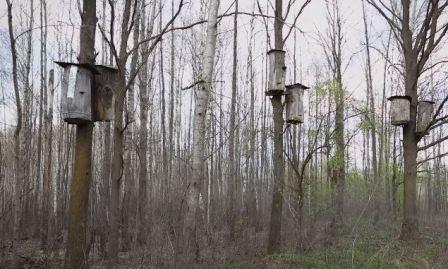
The tree on which there was one board was called a barn (staylinai), if there were two boards on one tree, it was called a twin, if there were three or four - a uterus.
The traditional production of a board by Belarusian beekeepers is a complex and time-consuming process, during which carpentry tools are used, such as a bart, a pick, a spatula, a drill-drill, a chisel, a scraper, and others. First, a rectangular hole (longitudinal) 60 * 14 cm in size was made on the sunny side, through which a side chamber was hollowed out, which was then cleaned. The back, opposite part of the side was called the shoulders. Functionally, there were three parts in the trapezoidal chamber side: the head (cap), where the swarm was located, the middle one - a place for honeycombs, the lower one (podak, pod) - a free place under the combs, where dead bees fell, various garbage. If necessary, top dressing was placed at the bottom.
Honey base of Belarus
Bees fly into the board and fly out of it through a small hole - a fly-hole (letka, letva, wok, walkers). To strengthen and rebuild honeycombs, a wooden cross was placed in the middle of the board (grabenka, kryzhachok). The inlet (dauzhtk, douzh, loophole, tvarka, eyelids) was tightly closed with a one- and two-part plank with edges beveled in the middle (douzhan, duluzhnya). Additionally, the board was closed with a snetam (sned, snedz, filmed) - a board that was fastened over the inlet with wooden fingers, and could be covered with birch bark for insulation.
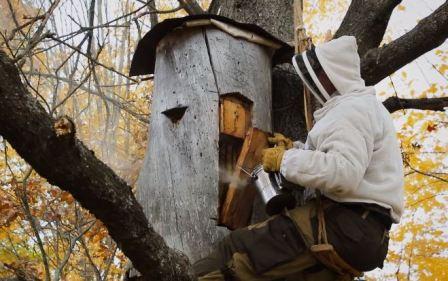
In order to climb onto the side-tree and work on it, they used such devices as lezgva and astrow. Astrow is a tree trunk with not completely cut branches, along them, like a ladder going up, the beekeeper climbed to the side. Lezgva (lasgvo, lezgva, plets, plyatsyonka, lgpa, tug, uzhyshcha, jen) - a device, the main part of which is a rope woven from strips of raw leather or hemp 25 - 30 meters long, with a saddle (chair, lazvenya) at one end a hook or a loop on the second. Between them, closer to the seat, there was a device for adjustment - a case.
The beginning of the decline of beekeeping begins in the 14th century, when deforestation began.
The decline of beekeeping in Belarus accelerates in the 19th century. During this period, intensive deforestation begins and traditional beekeeping loses its former economic importance. At the same time, a collapsible beehive with retractable frames is being actively introduced in the apiaries of Belarus.
Nevertheless, the traditional Belarusian beekeeping continued to exist. Tools and devices of beekeeping, along with special skills and knowledge, have been passed down through the centuries from one generation to another, as a rule, within the same family. Therefore, even at the beginning of the 20th century, beekeeping in Belarus was very common.
Fighting in Belarus in the 20th century
In 1914, there were only 11% of frame hives on the territory of Belarus. The rest of the bee colonies were kept in boards and logs, although most of the bees were already in apiaries, and not in board trees in the forests.
In the twentieth century beekeeping in its classical (original) form was encountered as a relic type of beekeeping. For example, the hereditary beekeeper B. A. Koleskov (village Rashetniki, Rechitsa district, Gomel region) contained 500 bee colonies. The disappearance of beekeeping in Belarus was affected by the weakening of the populations of local forest bees - borovok (barovak) and the reduction in their numbers.
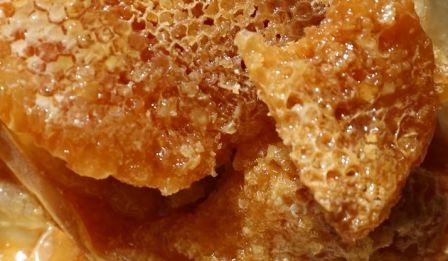
The beekeeping for the peasants was a significant help in the economy.
At the beginning of the twentieth century. many Belarusians preferred the forest form of deck beekeeping. Structurally, the deck (karashk, karen, kadaub, daubyak, daubyak, daubank, kalotka, stayak, stovpak, stayak, lazhak, lying) differed from the board only in that it was covered with birch, spruce or linden bark, boards. For the manufacture of decks, pine was usually used, as well as oak and alder. The deck was made from a butt of a tree with a height of 1.10 to 1.65 meters. According to the method of placement relative to the ground, there were two types of decks - vertical (stayak, stay, stayashk, stovpak) and horizontal (lyazhachy vuly, lyazhak, lie down).
The deck was made from a single piece of wood, hollowed out I cut the camera in the same way as in the board, or split the butt into two parts, gouging them, and then connecting and fixing them.
The deck was mounted either on a solid tree trunk, or on two parallel oak beams cut into the tree, or on a square platform around the tree. Several decks located on one tree (platform) formed a kind of forest apiary, convenient for beekeeping.
Intensive industrial forestry and the expansion of wood-chemical industries, the development of forests for arable land during the period of dominance of landlord and state forestries contributed to the spread of apiary beekeeping. The movement of hives from the forest to the village also occurred due to the unfavorable tax policy of forest owners, who took a honey tax from each side and deck (for example, in Mozyr district it was 30 kopecks).
The presence of bees in the apiary made it easier to observe them, and also made it possible to control the bees during swarming. The apiary was located in a village not far from its own farmstead or on the edge of a forest. Forest apiaries were fenced with poles; a small house, a hut or a booth for storing beekeeping tools could stand nearby. These apiaries still retained a relic of the forest form of beekeeping. This is indicated by the fact that trees in Polissya are an obligatory attribute of an apiary. At the same time, if the tree on which the hive stands for some reason dried up, the owner hung it with fresh green branches two or three times a week, if the hive was located on a stand, then the hive itself and the stand were hung with green branches.
The First World War caused great damage to beekeeping in Belarus. Many beekeepers were called up for war, a large number of apiaries were devastated, and a significant number of forests were also destroyed. The forest cover of Belarus has decreased by a third. In some localities, only 1 hive out of 10 remained. In general, in 1925 in Belarus, 64% of the hives still remained log hives, and the total number of hives was estimated at 136,448 hives.
In the interwar period, deforestation was actively going on in Western Belarus, which caused serious damage to the beekeeping of Belarus. During this period, beekeepers in Western Belarus actively switched their apiaries to collapsible hives. This was facilitated by the fact that it was difficult for beekeepers to obtain wood for making logs, having to buy or steal it from nearby private forests.
In the BSSR, there was a tendency to create state and collective farm apiaries, which were also equipped with collapsible beehives, as the most technologically advanced.
Another test for the Belarusian beekeeping was the Second World War. The reduction of forestry (in 1945 it decreased to 22%), the destruction of the material base of beekeeping, especially beekeeping, logs, beehives, had the most negative consequences for forestry. Do not forget that the traditions of beekeeping, as well as the instrument, were passed down from generation to generation within the same family, and the death of a large number of the population destroyed many dynasties of beekeepers in Belarus. However, the forest remained a place where both people and bees had a chance to survive. According to field records, some beekeepers continued to set up bees in the wooded areas during the war years and in the post-war years. For example, M.I. Karmanovich from the village. Until 1948, the Somsha of the Ivatsevichi district of the Brest region contained six boards in the forest.
In the post-war period, bee farms finally switched to the frame system of beekeeping. However, forest beekeeping has not disappeared. In some cases, beekeeping was found on the territory of Belarus. Some beekeepers in the Gomel region kept bees in poles as early as 1954. In some Polissya villages, pole beekeeping was widespread in the 50s and 60s.
Another blow in the 20th century to beekeeping in Belarus was caused by the varroa mite (Varroa), which was more convenient to fight in a frame hive. Sometimes the old beekeepers moved the boards closer to the estate, as it was difficult to place them in the forest. The location of the hives in the village was of great importance in the care of the bees.
In the post-war period, transitional hives became widespread - decks adapted for frames. Similar designs are found today. Home-made traditional tools and devices are being replaced with factory-made products that beekeepers purchase from specialized stores. Structurally, trap hives are reduced. They began to resemble small frame hives. Traps have practically ceased to be made from the bark. At the same time, deck-type hives are still used to catch bees.
The Ministry of Forestry of the BSSR contributed to the development of forest beekeeping by creating apiaries in forestries. This good tradition in Belarus - apiaries in forestries, has remained to this day.
Beekeeping in Belarus in the late XX - early XXI century.
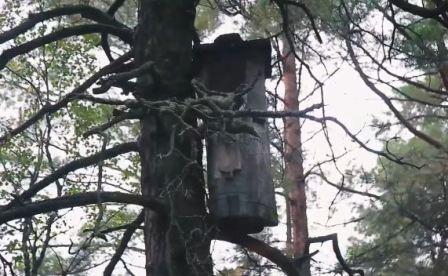
At the end of XX - beginning of XXI century. The development of beekeeping as a type of economic activity of Belarusians took place with varying degrees of beekeeping in the regions of Belarus. This process largely depends on local natural and geographical conditions.
and ethno-cultural features of the region. For example, the preservation of wild beekeeping in the "forest" form in the Belarusian Polissya to this day was caused by the presence of significant forests, on the one hand, and the peculiar isolation of the region and the conservatism of its inhabitants in economic activities.
In the 1990s, field beekeeping received renewed momentum for a renaissance. During the economic crisis, some beekeepers began to return to the ancient beekeeping in order to improve their financial situation. Among the areas of distribution of beekeeping, Petrikovsky, Lelchitsky and Naraulyansky districts of the Gomel region, Stolin, Pinsk and Ivatsevichy districts of the Brest region should be especially noted. In general, there are more than 200 hereditary beekeepers in the Belarusian Polissya. There is information about single onboard apiaries in the Berezinsky district of the Minsk region. Some Polissya beekeepers still keep several dozen decks and boards. Beekeepers prove the benefits of beekeeping in different ways. Most often, according to the answer of the beekeeper, this form of beekeeping practically does not require manufacturing costs, the beekeepers are inherited and the beekeeper continues the family tradition, the beekeeping almost does not require supervision, etc.
It should be noted that the younger generation of beekeepers in Belarus today already use drugs to treat bees from ticks, putting strips in the bead in spring and autumn. The beekeepers of the older generations, even now, do not process the bees in the bees, believing that only the strongest families should survive, so they get the purest honey. Needless to say, they are not far from the truth. For example, Professor Kashkovsky V. G. claims that the hives that are at high altitude are gradually cleared of the tick. He connects this with the fact that a weakened bee, on which the tick is located, simply does not reach the hive, being unable to rise to a height, all the same, the tick on the bee is the same as a few kilograms of cargo for a person, and the bee dies outside the hive, therefore the tick cannot move to the second bee and its number in the hive is reduced. Thus, the bees in the boards can resist the mite. Probably, there are some other mechanisms that allow the bees in the boards to resist the mite. This is indicated by the work of Ukrainian scientists who studied the tick in the boards located in the Ukrainian Polissya. They note that the mites in the sides are larger than their relatives in ordinary apiaries, but they did not find out the reason why this is happening. One can only assume that there is some mechanism by which the bees fight the mite - they damage it mechanically or there is a mechanism for clearing the mite when the bees visit flowering wild rosemary and thyme, or when they visit coniferous trees to collect pollen. You can not discount the mechanism of swarming bees. Bees in the boards, especially local populations of bees, swarm, and during swarming, the mass of the mite falls off.
Hereditary beekeepers claim that they receive several kilograms of honey from each side, while the honey collection is very dependent on the season.
Also, young people are actively adopting new technical innovations for the care of bees in the boards. The beekeepers of the older generations prefer to use the tools that they inherited from their grandfathers and great-grandfathers, not all old beekeepers even use gloves. According to some old beekeepers, they still use the decks that they inherited and which are 150 - 200 years old. Periodically, of course, the boards have to be repaired, especially in the area of the notch, where most often there can be damage caused by woodpeckers and martens.
It is noted that if before the beginning of the twentieth century, the ruin of the boards was a rather rare matter, and the rural community played a big role here, which could seriously punish the one who ruined the board. In modern conditions, the ruin and theft of boards is quite commonplace.
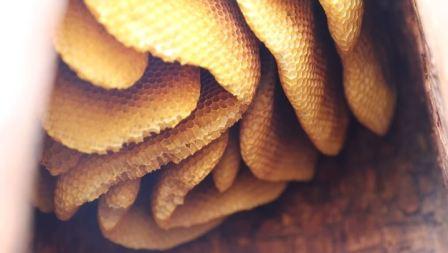
The beekeeping culture of Belarus and Poland
The importance and necessity of preserving forest beekeeping and beekeeping culture in Belarus and Poland is determined by a complex of economic, environmental and cultural prerequisites. In recent years, the problem of reducing the number of bees has become urgent all over the world, since it is the activity of bees for pollination that maintains diversity on Earth. Influence of bees on the preservation of forest flora, originality and diversity of higher flowering plants. The rescue and protection of honey bees, the development and support of beekeeping - both professional and amateur - are necessary not only for the conservation and sustainable development of nature, but also for ensuring food security. The organization of activities in the field of protection and support of beekeeping - an ancient Belarusian craft - is important from the point of view of preserving ethnic identity, national traditions, reviving and enriching Belarusian culture. Also, beekeeping in these areas may contribute to the preservation and revival of the valuable gene pool of local populations of the dark oh forest bee.
Borti and onboard instruments as memorabilia of Belarusian ethnography are presented in local history, ethnographic museums of Belarus, mostly occasionally, in funds and exhibitions dedicated to folk crafts and crafts (for example, the Belarusian State Museum of Folk Architecture and Architecture Ancient Belarusian Culture (1IEF named after K Nettles of the National Academy of Sciences of Belarus, Narolsky Ethnographic Museum, Private Museum of Nikolai Kachanovsky in the village of Kachanovichi, Pinsk region).
In the field of material culture, primarily aimed at preventing physical destruction, it should be noted that insufficient work is being done to identify and collect items related to the traditional beekeeping of Belarus. A significant obstacle to the acquisition of objects related to beekeeping and beekeeping in general for the museum is the lack of funds for their purchase, as well as the difficulties of storing and exhibiting them.
On November 25, 2016, an exhibition of works by Polish photographer Krzysztof Heike "The last European beekeepers I met" was held. At which the author presented to a wide audience the results of his many years of research on beekeeping (forest beekeeping) in Polissya, captured on his camera. At the beginning of the 21st century, he met Bortnikov on the liver and became interested in this phenomenon. His research once again confirmed that beekeeping is for the most part a family tradition, the beekeepers he found in Ukraine, Poland, Lithuania and Belarus, in some cases turned out to have common roots.
In 2019, the materials on the element "Forestry of Belarus and Poland", prepared by experts from the two countries, were sent to the Secretariat of the Convention for the Safeguarding of the Intangible Cultural Heritage of UNESCO - for inclusion in the List of Intangible Heritage. In December 2020, the beekeeping culture of Belarus was included in the UNESCO Intangible Cultural Heritage List.
By 2019, in Belarus, the element "Forest beekeeping of Polesie" received the status of a historical and cultural value.